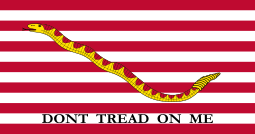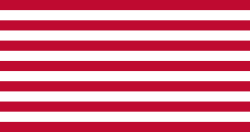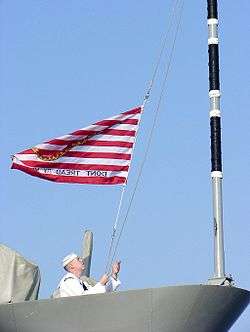First Navy Jack

The First Navy Jack is the current U.S. jack authorized by the United States Navy and is flown from the jackstaff of commissioned vessels of the U.S. Navy while moored pierside or at anchor. The design is traditionally regarded as that of the first U.S. naval jack flown in the earliest years of the republic.
History

In late 1775, as the first ships of the Continental Navy readied in the Delaware River, Commodore Esek Hopkins issued, in a set of fleet signals, an instruction directing his vessels to fly a "striped" jack and ensign. The exact design of these flags is unknown. The ensign was likely to have been the Grand Union Flag, and the jack a simplified version of the ensign: a field of 13 horizontal red and white stripes. It is likely that the colonial ships did not use (and could not have legitimately used) the canton of the Grand Union Flag (i.e., the Union Jack) as their jack given its use as a jack by Royal Navy warships. Despite the probability that the original jack may have been a simple striped flag, since about 1880, this jack has traditionally been depicted as consisting of thirteen red and white stripes charged with an uncoiled rattlesnake and the motto "Dont Tread on Me" [sic]; this tradition dates at least back to 1880, when this design appeared in a color plate in Admiral George Henry Preble's influential History of the Flag of the United States. Recent scholarship, however, has demonstrated that this inferred design never actually existed but "was a 19th-century mistake based on an erroneous 1776 engraving".[1]
In 1778, John Adams and Benjamin Franklin wrote a letter to the Ambassador of the Kingdom of Sicily, thanking him for allowing entry of American ships into Sicilian ports. The letter describes the American flag according to the 1777 Flag Resolution, but also describes a flag of "South Carolina, a rattlesnake, in the middle of the thirteen stripes."[2]
The rattlesnake had long been a symbol of resistance to the British in Colonial America. The phrase "Don't tread on me" may have been coined during the American Revolutionary War, a variant perhaps of the snake severed in segments labelled with the names of the colonies and the legend "Join, or Die" which had appeared first in Benjamin Franklin's Pennsylvania Gazette in 1754, as a political cartoon reflecting on the Albany Congress.
The rattlesnake (specifically, the Timber Rattlesnake) is especially significant and symbolic to the American Revolution. The rattle has thirteen layers, signifying the original Thirteen Colonies. Additionally, the snake does not strike until provoked, a quality echoed by the phrase "Don't tread on me." For more on the origin of the rattlesnake emblem, see the Gadsden flag.
Modern use
Shipboard

The First Navy Jack was first used in recent history during the United States' Bicentennial year, 1976, when all commissioned naval vessels were directed to fly it while moored or anchored for the entire year, this in lieu of the standard fifty-star Jack of the United States.
In 1980, Secretary of the Navy Edward Hidalgo directed that the warship or fleet auxiliary (e.g., a vessel designated as a "United States Ship" or "USS") with the longest active status shall display the First Navy Jack until decommissioned or transferred to inactive service.[3] Then the flag will be passed to the next ship in line.
At the time, the order disregarded the sailing frigate USS Constitution, which while technically the oldest vessel in the U.S. Navy (in service in 1797), did not display the flag. As such, the honor of "oldest ship" in the Fleet was conferred on the following U.S. Navy vessels:
- 1981–1982: Destroyer tender USS Dixie (AD-14), commissioned in 1940
- 1982–1993: Destroyer tender USS Prairie (AD-15), commissioned in 1940
- 1993–1993: Submarine tender USS Orion (AS-18), commissioned in 1943
- 1993–1994: Destroyer tender USS Yosemite (AD-19), commissioned in 1944
- 1994–1995: Repair ship USS Jason (AR-8), commissioned in 1944
- 1995–1995: Ammunition ship USS Mauna Kea (AE-22), commissioned in 1957
- 1995–1998: Aircraft carrier USS Independence (CV-62), commissioned in 1959
- 1998–2009: Aircraft carrier USS Kitty Hawk (CV-63), commissioned in 1961
- 2009–2012: Aircraft carrier USS Enterprise (CVN-65), commissioned in 1961
- 2012–2014: Amphibious transport dock USS Denver (LPD-9), commissioned in 1968
- 2014-present: Amphibious command ship USS Blue Ridge (LCC-19), commissioned in 1970
On 31 May 2002[3] the Secretary of the Navy issued SECNAV Instruction 10520.6, directing all warships and auxiliaries of the U.S. Navy to fly the First Naval Jack as a "temporary substitution" for the Jack of the United States "during the Global War on Terrorism". This was based on a late 2001 post-9/11 suggestion from retired Captain Brayton Harris (who in 1975–76 had been Special Assistant to the Secretary of the Navy for the bicentennial). Most vessels made the switch on September 11, 2002, the first anniversary of the terrorist attacks.
This directive only applied to commissioned vessels of the U.S. Navy, to include the previously excluded USS Constitution. Commissioned vessels of the U.S. Coast Guard designated as "United States Coast Guard Cutter" ("USCGC") and USCG patrol boats, vessels of the National Oceanographic and Atmospheric Administration, and the predominantly civilian-manned vessels of the U.S. Navy's Military Sealift Command designated as "United States Naval Ship" ("USNS") would continue to fly the Jack of the United States from their jackstaffs while moored or at anchor.
This First Navy Jack, along with the Serapis flag, is also featured on the crest of the Arleigh Burke class guided missile destroyer USS John Paul Jones (DDG-53).[4]
Other U.S. Navy uses
Since 11 Sep 2001, the First Navy Jack has also been flown on an optional basis from multi-halyard gaff-rigged flagpoles aboard U.S. Navy installations and facilities ashore, such use always being in addition to the flying of the United States ensign.
The First Navy Jack has also been authorized for wear as a patch by sailors and naval officers on flight suits and certain versions of the Navy Working Uniform (NWU), including sailors and naval officers wearing the Army Combat Uniform (ACU) while assigned to and serving with Army units, at the discretion of the local Army commander.[5][6] For the NWU and ACU, the patch is typically worn on the opposite sleeve as the U.S. flag.
Sailors and naval officers assigned to the International Security Assistance Force (ISAF) are also authorized to wear the First Navy Jack on their Army Combat Uniform (ACU)/Operation Enduring Freedom Camouflage Pattern (MultiCam) on the right sleeve, below the American flag. [7]
Other non-military uses
Like other snake flags, unsanctioned use of the First Navy Jack has also been used by individuals or individuals in the United States (e.g., external to the U.S. Navy) as a sign of protest or commemoration. For example, opponents to a smoking ban in Franklin, Indiana fly Navy Jacks outside their homes and businesses.[8] Conversely, a First Navy Jack flag was also placed at a makeshift memorial on Boylston Street following the Boston Marathon bombings.[9][10]
See also
References
- ↑ Ansoff, Peter. (2004). The First Navy Jack. Raven: A Journal of Vexillology, 11, ISSN 1071-0043, LCCN 94-642220.
- ↑ The Revolutionary Diplomatic Correspondence of the United States, Volume 2 Available
- 1 2 "The U.S. Navy's First Jack". Retrieved 2006-10-01.
- ↑ See the patch and description on the official website at http://www.public.navy.mil/surfor/ddg53/Pages/ourShip.aspx
- ↑ office of the Chief of Naval Operations. "SPECIAL UNIFORM SITUATIONS FOR NAVY PERSONNEL ASSIGNED TO AND SERVING WITH AN ARMY UNIT". VADM MARK FERGUSON. Retrieved 2013-07-31.
- ↑ David Tomiyama. "Deployed USS Sampson FC2 earns award in Afghanistan". Provincial Reconstruction Team Khost Public Affairs. Retrieved 2012-02-06.
- ↑ US National Support Element. "US National Standards, HQ, International Security Assistance Force" (PDF). Headquarters, International Security Assistance Force. Retrieved 2013-07-31.
- ↑ "Red, White, Rattlesnake – Opponents Fight Smoking Ban – Indiana News Story – WRTV Indianapolis". Theindychannel.com. 2006-04-28. Retrieved 2011-05-30.
- ↑ "Boylston Street Marathon Memorial" (JPG). Sarahfit.com. Retrieved 2015-08-11.
- ↑ "Boylston Memorial" (JPG). S3.amazonnaws.com. Retrieved 2015-08-11.
External links
| Wikisource has original text related to this article: |
| Wikimedia Commons has media related to First Navy Jack. |
- US Naval Historical Center's First Jack article
- CDR Michel T. Poirier, "A Brief History of the U.S. Navy Jack", in Undersea Warfare
